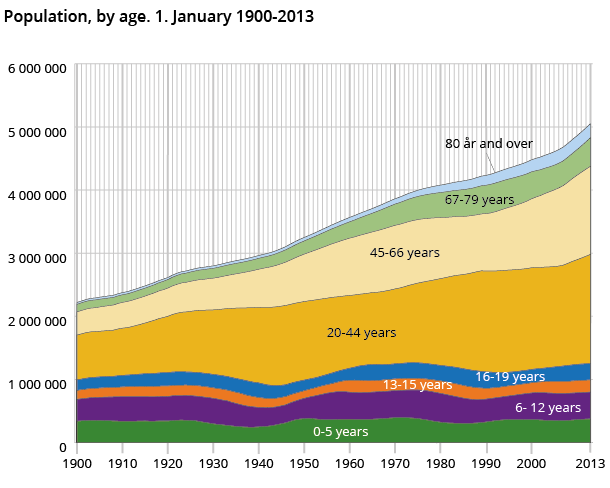Content
Published:
This is an archived release.
Continuously increasing surplus of males
2 535 900 males and 2 515 400 females were registered as residents of Norway as per 1 January 2013. Therefore there were 20 500 more males than females, and this surplus was almost twice as high as the year before. In 2010 the surplus of males was 1 400.
| 2013 | Change in per cent | |||
|---|---|---|---|---|
| 2012 - 2013 | 2008 - 2013 | 2003 - 2013 | ||
| The age-group "80-89 years" was changed to "80 years and over" 11th March 2013 at 15:50 pm. No change in the figures. | ||||
| Total | 5 051 275 | 1.3 | 6.6 | 11.0 |
| 0 years | 60 530 | 0.1 | 3.2 | 8.8 |
| 1-5 years | 314 484 | 0.8 | 7.5 | 5.5 |
| 6-12 years | 426 509 | 0.4 | -1.0 | -2.1 |
| 13-15 years | 190 264 | -0.6 | 0.8 | 7.4 |
| 16-19 years | 261 666 | 0.8 | 3.7 | 21.3 |
| 20-44 years | 1 728 068 | 1.4 | 6.9 | 8.1 |
| 45-66 years | 1 396 542 | 1.3 | 8.7 | 19.8 |
| 67-79 years | 451 627 | 4.3 | 14.3 | 12.9 |
| 80 years and over | 221 585 | 0.0 | 1.4 | 8.1 |
From January 2012 to January 2013 the number of males increased by 37 000 while the number of females increased by 28 400. From 1975 the sex distribution has changed, from a surplus of females of 25 000, or one per cent, to the present surplus of males. The age composition in the population has also changed significantly over time.
100 years ago Norway had half the population of today. At that time 396 000 were children under the age of seven. Today there are 437 000 children under the age of seven, that is an increase of only 41 000. 100 years ago these children constituted 16 per cent of the population, whereas today it is 8.5 per cent. Simultaneously, at that time there were 161 000 people over the age of 66. That number is today 673 000, which is an increase of more than half a million. 100 years ago people over the age of 66 constituted 6.5 per cent of the population, today the share is twice as high.
About advance releasesOpen and readClose
More details about citizenship and marital status will be published on 13 March.
More details about marriages and divorces will be published 22 August.
Contact
-
Magnus Haug
E-mail: magnus.haug@ssb.no
tel.: (+47) 40 81 14 91
-
Karstein Sørlien
E-mail: karstein.sorlien@ssb.no
tel.: (+47) 47 70 16 35
-
Linn Krokedal
E-mail: linn.krokedal@ssb.no
tel.: (+47) 95 47 97 47
-
Anders Sønstebø
E-mail: anders.sonstebo@ssb.no
tel.: (+47) 46 66 37 74
-
Espen Andersen
E-mail: espen.andersen@ssb.no
tel.: (+47) 92 61 00 46
-
Statistics Norway's Information Centre
E-mail: informasjon@ssb.no
tel.: (+47) 21 09 46 42
-
Oppdrag befolkningsstatistikk
E-mail: befolkning@ssb.no

